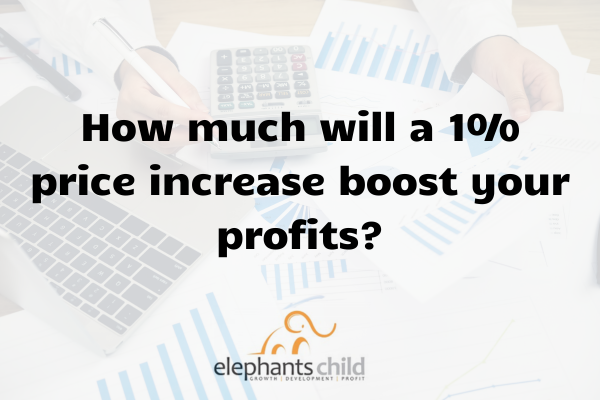How much will a 1% price increase boost your profits?
Pricing a product is a combination of both an art and a science. It requires a balance of financial considerations and personal values. A business owner must consider how a product or service contributes to overhead and how that will drive profitability, as well as how their pricing strategy will impact their marketing and competition. Prices can be set based on cost, or those of your competitors or the value you can create in the eyes of the customer – value based pricing. Steve Bird, one of our Business Growth Advisors explains the benefits of focusing on value.
What is Value Based Pricing?
Imagine you are at the supermarket and you want to buy a tin of baked Beans. Two tins catch your eye, the store’s own-label and a branded product. The first costs £1.20 and the second costs £1.40. How do you choose? You ask yourself, is the brand name can worth 20 pence more, is the second tin of beans “worth” it?
This is how our customers make decisions when they deliberate about which product to purchase, even if the decision is ultimately not to buy anything.
Is it worth it? To answer this, you think of everything that is different between the two tins of beans. You may have had better experiences with the branded variety. One may have less salt. One may have a thicker sauce. One may have a prettier label. It’s completely up to you as to what you think is important. After you’ve determined the important differences, you place a value on them and then decide if the branded tin of beans is worth 20 pence more than the own label can.
Of-course you don’t actually do these calculations. But that is how your brain makes the decision. You ask yourself and answer the question, is the brand name tin worth 20 pence more than the own-label tin?
The best product strategies understand how these calculations are made and segment their market based on these decisions and who makes them.
Why pricing should be your company’s top priority?
Firstly, if your company is not setting the right prices for their target markets, there are hidden profits waiting to be tapped. Second, small changes in price can lead to a significant increase in profits. McKinsey & Co. studied elasticity of demand at the Global 1200 and found that if they raised prices by just 1% — and demand remains constant — profits would go up on average by 11%. Now just ask yourself how much will a 1% price increase boost your profits?
Increase Profits by Offering Value Choices
One of the most effective pricing strategies involves offering a “value based range” good, better, and best product versions. Gourmet chefs often have early-bird, set-menu, A la Carte, and chef’s table options. I’ve found that customers appreciate being offered pricing options instead of just one “take it or leave it” price, particularly at the quality end of the market.
This strategy allows customers to choose how much to pay and it’s often surprising how many people select the “best” and most profit-laden version.
The whole concept of value rather than cost based pricing or mark-up allows us to target an offer to people who appreciate the qualities or features of the products, and therefore will pay a premium to drive increased profits.
At the other end of the spectrum, Every Day Low Price (EDLP) allows retailers to build consumer confidence and loyalty. Customers learn to associate a company’s brand with quality products that are sold at perceived low prices (think Aldi). A company must convince consumers that its product is of both high quality and low price. If this can be achieved, then customers will perceive the product to be of an overall great value, irrespective of the margin the product generates for the retailer. EDLP can still be value based not cost plus.
Ask your customers
Notice there is no right or wrong answer. People are different and value things differently. For your business, the important thing is to ask your customers what they would have bought if your product or service was unavailable. Their answers tell you who your toughest competitors are.
Now, choose one of these competitors and do the value-based pricing analysis on their range. How much is your product or service? How much is your competitor’s? What are all the differences? (Don’t be biased. Be sure to list the areas where your competitor is better.) How would you value these differences? How do you think your customers value these differences?
To conclude, where possible, try to price value not cost. Add in elements to your product that have a low-cost base but a high perceived or real value.
As a Business Growth Advisor with Elephants Child, I am very happy to help you think through these issues as part of a programme of support. Contact Steve to discuss further
